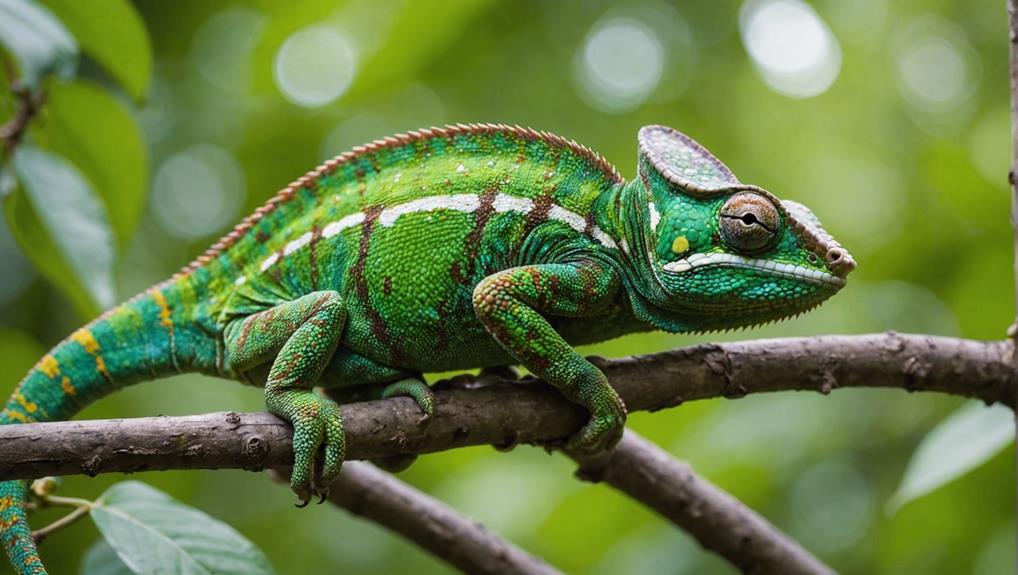Senegal chameleons are masters of disguise, adapting to their environments with fascinating behaviors.
They thrive in dense forests and savannas, where they blend into the vegetation.
These chameleons change color to regulate temperature and communicate, using skin cells called chromatophores.
When hunting, they rely on stealth and their long, sticky tongues to catch prey.
Socially, they're mostly solitary, but show vibrant displays during mating rituals and territorial disputes.
Females lay eggs in burrows to protect them until they hatch, showcasing their remarkable ability to survive in diverse habitats.
Habitat and Environment
Senegal chameleons thrive in the dense, humid forests and savannas of West Africa. These environments offer them the freedom to explore and adapt to the ever-changing climate. You'll find that these chameleons are masters of climate adaptation, making the most of their surroundings to stay alive and flourish.
Living in such diverse habitats, Senegal chameleons have developed unique strategies to cope with varying temperatures and humidity levels. They prefer areas with plenty of vegetation, where they can easily find food and shelter. By staying close to the ground or climbing trees, they can regulate their body temperature and avoid predators. This adaptability is essential for their survival, especially in regions where the climate can be unpredictable.
However, the natural habitats of Senegal chameleons are under threat. Deforestation and human encroachment are major challenges that disrupt their environment. To safeguard their survival, habitat conservation efforts are essential. You can play a part by supporting initiatives that protect these essential ecosystems.
By raising awareness and contributing to conservation projects, you help preserve the lush forests and savannas these chameleons call home. In addition to protecting their habitats, it's important to understand how climate change impacts these creatures. As temperatures rise and weather patterns shift, their ability to adapt will be put to the test.
Color Change Mechanisms
Understanding their habitat is key to grasping how these chameleons use their remarkable color change mechanisms to adapt and survive. Senegal chameleons, native to the forests and savannas of West Africa, rely on their surroundings to blend in and communicate.
You might think their color changes are solely for camouflage, but these shifts also play a pivotal role in mood regulation and predator avoidance.
When a Senegal chameleon senses a threat, its skin can shift through a spectrum of colors. This adaptive ability isn't just a matter of blending into the background, but also a means to startle or confuse predators.
The rapid changes can make the chameleon appear larger or more menacing, giving it a better chance to escape. You can see how this tactic would grant them a certain freedom, evading danger in the wild.
Mood regulation is another fascinating aspect of their color change. Unlike other reptiles, Senegal chameleons have skin cells called chromatophores that expand or contract to display different colors.
These changes can indicate stress, excitement, or even contentment. When you observe a chameleon turning dark, it's often a sign of stress or fear, whereas brighter colors can mean the chameleon is feeling dominant or ready to mate.
It's impressive how these chameleons harness such complex mechanisms. By understanding these processes, you gain insight into their behavior and the sophisticated ways they navigate their environment.
Feeding and Hunting Techniques
When it comes to hunting, these chameleons employ a combination of stealth and precision to capture their prey. You'll notice that the Senegal Chameleon uses its ability to remain motionless and blend into its surroundings to avoid detection. This is vital for effective prey detection, allowing the chameleon to spot insects and other small creatures without being noticed.
Once the target is identified, the chameleon's remarkable tongue projection comes into play. The tongue can extend up to twice the length of its body, launching with incredible speed to snag prey. This process happens so quickly that the prey has little chance to escape. Here's a quick breakdown of the hunting process:
| Hunting Stage | Description |
|---|---|
| Prey Detection | The chameleon remains still and uses its eyes to locate prey. |
| Stealth Approach | It slowly moves closer without alerting the prey. |
| Tongue Projection | The tongue shoots out with precision to capture the prey. |
| Consumption | The prey is pulled back into the mouth and eaten. |
The chameleon's eyes play a key role in prey detection. They can move independently, allowing the chameleon to have a 360-degree view of its surroundings. This unique ability guarantees that the chameleon can spot potential prey from various angles without moving its body.
When you observe a Senegal Chameleon hunting, you're witnessing a finely-tuned predator in action. Its combination of stealth, precision, and specialized physical traits makes it an efficient hunter. By mastering these techniques, the Senegal Chameleon secures its survival in the wild, showcasing the incredible adaptability of nature's creatures.
Social Interactions
Beyond their hunting prowess, these chameleons exhibit fascinating social behaviors that reveal much about their interactions with one another. Senegal chameleons are generally solitary creatures, but when they do interact, their behaviors are quite intriguing.
One key aspect of their social life is territory defense. These chameleons are very territorial and will defend their space aggressively. If another chameleon encroaches on their area, you'll notice a range of behaviors intended to ward off the intruder, such as color changes and physical posturing.
Communication signals play a significant role in how Senegal chameleons interact. They use a combination of visual and physical signals to convey messages to each other. For instance, they often change the color of their skin to signal their mood or intentions. Bright, vibrant colors usually indicate aggression or dominance, while more subdued hues can signify submission or neutrality.
Three key behaviors to observe are:
- Color Changes: Chameleons use their remarkable ability to change color not just for camouflage but also to communicate their emotional state and intentions.
- Body Posturing: They might puff up their bodies or display other physical postures to assert dominance or scare off potential threats.
- Head Bobbing: This behavior is often a form of greeting or a way to show interest, especially during encounters with other chameleons.
Understanding these behaviors allows you to gain insight into the complex social dynamics of Senegal chameleons. Their interactions, though limited, are rich with meaning and vital for their survival in the wild.
Reproduction and Lifespan
Senegal chameleons have a fascinating reproductive cycle that includes unique courtship behaviors and distinct stages of development.
When males are ready to mate, they display vibrant colors and engage in mating rituals to attract females. You might observe males bobbing their heads and swaying their bodies to catch a female's attention. Once the female is receptive, the actual mating process is relatively quick and straightforward.
After successful mating, the female begins the process of egg incubation. She'll find a suitable spot, usually in soft soil, where she can dig a hole to lay her eggs. This is an instinctual behavior that protects the eggs from predators. You should note that the number of eggs can vary, but a typical clutch contains between 20 to 30 eggs.
The incubation period lasts around six to nine months, depending on environmental conditions like temperature and humidity.
Once the eggs hatch, the baby chameleons are fully independent and need no parental care. They start their lives ready to fend for themselves, exhibiting the same behaviors as adult chameleons, such as hunting for small insects.
Regarding their lifespan, Senegal chameleons typically live for about 5 to 7 years in captivity. However, their lifespan can be shorter in the wild due to various environmental pressures and predation risks.
Understanding these aspects of their reproduction and lifespan gives you a deeper appreciation for the resilience and adaptability of Senegal chameleons. Their unique mating rituals and egg incubation practices highlight the incredible ways nature safeguards the survival of these fascinating creatures.
Conclusion
The Senegal chameleon thrives in diverse habitats, using color change for communication and camouflage.
Its feeding involves precise hunting techniques, primarily targeting insects.
Social interactions are generally solitary, except during mating seasons.
With a clear understanding of these behaviors, you can better appreciate the unique adaptations of the Senegal chameleon.
Their fascinating lifestyle and survival strategies offer valuable insights into the complexity of reptilian life.


